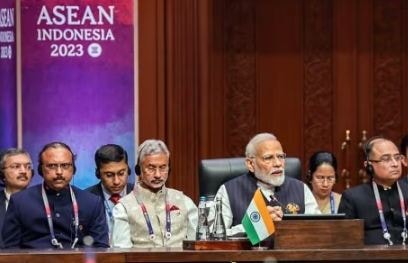
Both Brunei and Singapore are key partners in India’s Act East Policy and the Indo-Pacific vision. The Prime Minister’s visit aims to strengthen these relationships and expand India’s engagement with the broader ASEAN region.
PM Modi expressed confidence that these visits will contribute significantly to strengthening India’s strategic ties with Brunei and Singapore, and bolster its engagement with the ASEAN bloc.
KEY TAKEAWAYS
1. According to the ASEAN website: On 8 August 1967, five leaders – the Foreign Ministers of Indonesia, Malaysia, the Philippines, Singapore and Thailand – came together in Bangkok. Thailand was brokering some disputes among Malaysia, Indonesia and the Philippines, and it eventually led to the signing of a document- ASEAN Declaration.
2. The five Foreign Ministers who signed it – Adam Malik of Indonesia, Narciso R. Ramos of the Philippines, Tun Abdul Razak of Malaysia, S. Rajaratnam of Singapore, and Thanat Khoman of Thailand – would subsequently be hailed as the Founding Fathers of ASEAN.
3. Over the next few decades, five other countries joined them – Brunei Darussalam, Lao PDR, Cambodia, Myanmar and Vietnam.
Story continues below this ad
4. They have an anthem, a flag and biannual summits (twice a year) with a rotating chairmanship. Its official motto is “One Vision, One Identity, One Community”.
5. The ASEAN Declaration conveyed the aspiration to further regional cooperation in the economic, social, cultural, technical, educational and other fields, and in the promotion of regional peace and stability and adherence to the principles of the United Nations Charter.
6. The Association keeps itself open for participation by all States in the Southeast Asian region subscribing to its aims, principles and purposes.
7. Its major pillars are Political-Security Community (APSC), Economic Community (AEC) and Socio-Cultural Community (ASCC).
JUST FYI: India and ASEAN
Story continues below this ad
 Prime Minister Narendra Modi addresses the 20th ASEAN-India Summit, in Jakarta, Thursday, Sept 7, 2023. (PTI Photo)
Prime Minister Narendra Modi addresses the 20th ASEAN-India Summit, in Jakarta, Thursday, Sept 7, 2023. (PTI Photo)
8. ASEAN is central to India’s Act East policy, which focuses on the extended neighbourhood in the Asia-Pacific region.
9. India’s Act East policy was originally conceived as an economic initiative but has gained political, strategic and cultural dimensions including the establishment of institutional mechanisms for dialogue and cooperation.
10. India is part of the ASEAN Plus Six grouping. The other countries in this grouping includes China, Japan, South Korea, New Zealand and Australia as well.
11. In 2010, a Free Trade Agreement was also signed and entered into force between India and ASEAN. While India was part of negotiations to join the Regional Comprehensive Economic Partnership (RCEP) in 2020, it ultimately decided not to do so. However, in the past eight years, trade has grown in terms of value, barring the pandemic years of 2020 and 2021.
Story continues below this ad
12. India and ASEAN started to hold summits together in 2002 — a decade after the country established formal engagement with the group.
BTW:
Speaking at the 20th ASEAN-India summit in Jakarta, Indonesia’s capital, Prime Minister Narendra Modi on September 7, 2023 said ASEAN (Association of Southeast Asian Nations) is the “central pillar” of India’s Act East Policy and the country fully supports the group’s centrality and outlook on the Indo-Pacific.
Highlighting the need to build a rule-based post-Covid world order, Modi added that the progress of a free and open Indo-Pacific and elevating the voice of the Global South is in the common interest of all.
Beyond the term: Global South
As India assumed the presidency of the G20 group of countries for 2022 to 2023, Indian External Affairs Minister S Jaishankar said that the country would be the “voice of the Global South, that is otherwise under-represented in such forums”.
Story continues below this ad
‘Global North’ refers loosely to countries like the US, Canada, Europe, Russia, Australia and New Zealand, while ‘Global South’ includes countries in Asia, Africa and South America.
What sets the terms Global North and South apart ?
1. They are arguably more accurate in grouping like countries together, measuring similarly in terms of wealth, indicators of education and healthcare, etc.
2. Another commonality between the South countries is that most have a history of colonisation, largely at the hands of European powers.
3. This classification trains more focus on the Global South. When leaders mention it, they are also pointing to the region’s historical exclusion from prominent international organisations – such as from the permanent membership of the United Nations Security Council.
Story continues below this ad
(As bodies like the UN and the IMF are involved in major decision-making that affect the world in terms of politics, economy and society, the exclusion is seen by these countries as contributing to their slower growth)
Point to ponder: ‘Our history and geography connect India and ASEAN’. Discuss.
Subscribe to our UPSC newsletter and stay updated with the news cues from the past week.
Stay updated with the latest UPSC articles by joining our Telegram channel – IndianExpress UPSC Hub, and follow us on Instagram and X.
For your answers, queries and suggestions write at manas.srivastava@indianexpress.com



 Prime Minister Narendra Modi addresses the 20th ASEAN-India Summit, in Jakarta, Thursday, Sept 7, 2023. (PTI Photo)
Prime Minister Narendra Modi addresses the 20th ASEAN-India Summit, in Jakarta, Thursday, Sept 7, 2023. (PTI Photo)






























